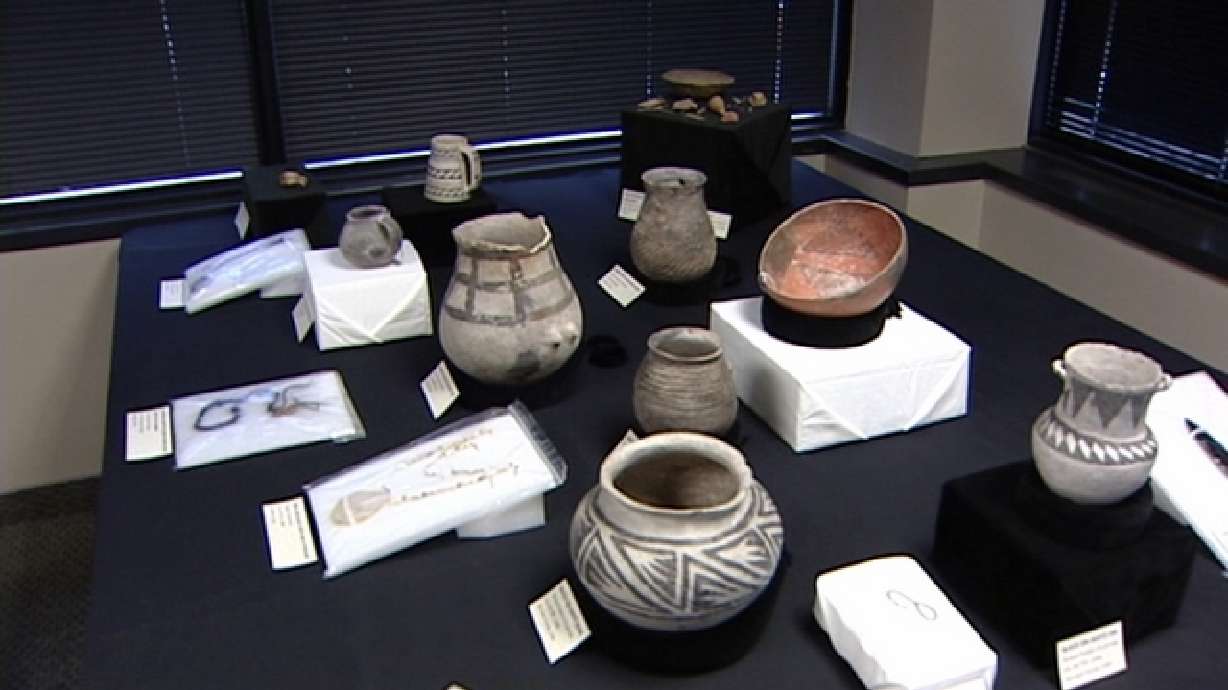Estimated read time: 4-5 minutes
This archived news story is available only for your personal, non-commercial use. Information in the story may be outdated or superseded by additional information. Reading or replaying the story in its archived form does not constitute a republication of the story.
SALT LAKE CITY (AP) -- Once the legal dust settles from the nation's biggest bust of Southwestern artifact looting, federal officials face another daunting task: deciding what to do with the ancient sandals, pipes, pendants and thousands of other items associated with the investigation.
It could take years to sort through the ancient Native American relics -- seven truckloads have been collected already this summer -- and determine where each should go, said Emily Palus, the U.S. Bureau of Land Management's national curator in Washington, D.C.
Most of the items from those found guilty will likely end up in hand-picked public museums in the Four Corners region or with an American Indian tribe.
"Ultimately the people will benefit. Collections will be curated and made available to the public for research and exhibitions," Palus said.
Federal officials have done this kind of work before -- violations of national archaeological laws aren't rare -- but Palus can't remember facing the prospect of finding homes for so many objects related to criminal cases.
For now, the items taken by government agents remain boxed in a secure, climate-controlled building in Salt Lake City. Most are carefully wrapped in acid-free paper and surrounded by special foam or other protective material, Palus said.
They range from the very fragile, like ancient sandals woven from reeds, to more robust items like boulders used for processing corn.
Federal agents spent more than two years on the investigation, building criminal cases based largely on recorded deals between an artifacts dealer secretly working for the government and a variety of buyers, sellers and collectors.
So far, 26 people from Utah, Colorado and New Mexico have been indicted for illegally taking or trafficking in artifacts from public or tribal lands. Two have committed suicide, two pleaded guilty this summer and the rest have pleaded not guilty.
The fate of the artifacts collected by the government will first be determined by the outcome of the legal cases. Those found not guilty will get their items back. Artifacts from those found guilty will begin a long process of disposition.
Work on the first batch may begin soon.
Jeanne Redd and her daughter Jerrica are scheduled to be sentenced in Salt Lake City on Wednesday. They pleaded guilty to several felony charges in July. As part of the plea deal, they relinquished their entire artifact collections, which required two moving trucks to haul away.
Last month, federal agents used five moving trucks to loaded thousands of artifacts from the Durango, Colo., home of antiquities dealer Vern Crites, who surrendered his collection after being named in federal charges earlier this summer.
Still other items were seized in a series of arrests in June in southern Utah.
If sacred or ceremonial objects are returned to the Navajo Nation, officials there will look for a tribal member who can use them in ceremonies, said Alan Downer, manager of the Navajo Nation's historic preservation department.
"We don't want to see them go unused," Downer said.
Archaeological objects will be dealt with individually. Downer said displaying certain artifacts may not be consistent with Navajo traditions.
Still, they'd be happy to get back any items illegally taken from tribal land.
"The sense around here is that this is a good thing," Downer said.
Human remains, burial and sacred objects from federal land will be dealt with under the 1990 Native American Graves Protection and Repatriation Act, which requires that items affiliated with native people be returned to tribes.
Other items from public land will be categorized, researched and placed with museums and other institutions that meet federal guidelines to make sure they are treated well, safely protected and made available to the public or researchers.
There are about 10 museums in the region that might qualify for artifacts from the Four Corners cases, Palus said.
"We'd certainly be interested," said Duncan Metcalfe, chief curator at the Utah Museum of Natural History at the University of Utah.
Although the much of the scientific value has been lost because the items were apparently removed from the ground without careful archaeological study, there's still a benefit for researchers, he said.
"The arsenal of techniques we have for examining individual items has increased dramatically over the last 10 years," Metcalfe said.
Museums, though, will have to temper their enthusiasm for the artifacts with the reality of a commitment to make sure they're stored properly, safeguarded from the elements and handled according to the government's requirements, he said.
That all requires money and space, which is often in short supply at museums.
Palus said the federal government would likely provide some kind of initial payment for institutions to take care of the objects.
Some of the items could end up back at the epicenter of this summer's artifacts raids: Blanding, Utah, the hometown of 17 of those charged. The city's Edge of the Cedars Museum has taken items from criminal cases in the past and meets federal requirements, said director Teri Paul.
The museum, like others, has limited amounts of exhibit space. But Paul said they try to rotate most items through their exhibits at least once a year.
Providing public access to the objects taken from public land is one upside to cracking artifact trafficking cases, Palus said.
"Otherwise, they would remain in living room, basements and garages," she said.
(Copyright 2009 by The Associated Press. All Rights Reserved.)








